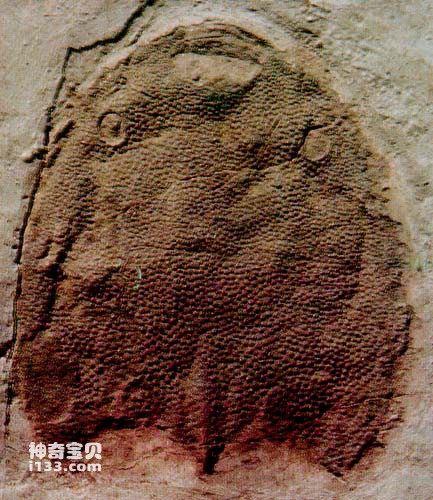Before the earliest vertebrates were discovered in the Chengjiang fauna in China, scale fossils with bony structures found in the Ordovician freshwater sedimentary rocks in Colorado, USA, had been the remains of the earliest vertebrates.

Morse fish
More complete early vertebrate fossils have been found in marine sediments of the Middle Silurian in England. They represent some very primitive vertebrates that looked like fish: the body was slender and tubular; there were no upper and lower jaws, only at the front end of the body. It has a sucker-shaped mouth; there are a row of circular gill openings behind the eyes and on both sides of the head; it has a tail fin divided into upper and lower lobes, with the lower lobe longer and the upper lobe shorter and higher - this type of tail is called a crooked tail. Tail shape. Such animals have many similarities with the modern lampreys that still live in the ocean, and they are named respectively mothfish and flower scale fish.
In the Devonian Period, this large group of early vertebrates reached a prosperous period, and fossils of various jawless fish-shaped vertebrates have been found all over the world. They have no upper and lower jaws, and the mouth as a feeding organ cannot effectively open and close. They can only rely on sucking or even relying on the natural flow of water to bring food into their mouths for consumption; therefore, they are called jawless, and they are in the category of animals. It is collectively classified into the class Agnatha of the general order Fish-shaped. In addition, they have no true fins, and their axial skeleton is only cartilage rather than true bone (i.e. hard bone). The representative jawless fish have bony plates or scales on their front body surface, which are connected to each other like the armor of ancient warriors and play a role in protecting the body. Therefore, they are generally called armored fish.
There are still considerable differences between different groups of jawless animals. It is likely that these different groups have each undergone a long evolutionary process before the time of their fossil record. Based on these differences, all jawless species, including modern types, can be divided into the following two subclasses and several orders:

Fossilized multibranchial fish head shield
Mononaris subclass: characterized by a single nostril, multiple gill pores, and a bony cranial shield (i.e., the bony armor of the head). It consists of 4 orders, namely, Cephalothorax, Armored Fish, Lactostomata and Cyclostomata. Cylostomes are modern jawless animals that include lampreys.
Subclass Binares: Characterized by having a pair of inner nostrils and no external nostrils; diverse shapes and complex nail plates. Includes 3 orders, namely fin-shelled turtles, platychopods and multibranched fishes.
Multibranchial fishes are jawless fish unique to China, mainly found in Qujing, Wuding and other places in Yunnan. They not only have a pair of internal nostrils, but also have bony vertebrae that have not yet appeared in cephalothurans; however, their bony vertebrae, like lampreys, are still rudimentary and only stand on the notochord. The small bone fragments on the side and no other components.
The distribution of armored fishes in geological history is relatively limited, extending only into the Devonian period. They may have originated in the Ordovician period, developing from earlier, unarmored ancestors, and the mothfish may be a remnant of those ancestral forms. Armored fishes developed into a large group of animals adapted to various aquatic ecological environments and with various living habits during the Devonian Period, which can be said to have achieved temporary success.
When many more advanced jawed vertebrates that developed rapidly along different evolutionary lines gradually emerged from the Devonian Period, the jawless armored fishes eventually failed in the competition for survival. By the end of the Devonian period, except for a few remaining species adapted to a special lifestyle, the vast majority of armored fishes had withdrawn from the stage of history.
animal tags: lamprey
We created this article in conjunction with AI technology, then made sure it was fact-checked and edited by a Animals Top editor.